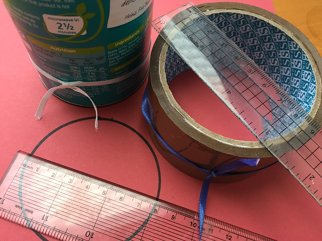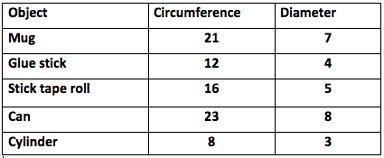Pi day can be a whole school event, with KS1 children finding circles and KS2 children discovering a simple Pi pattern through measuring, using multiplication and division facts for x3 and rounding to the nearest whole number. Other Pi based activities include rounding decimals, looking at the format that dates are written around the world and, of course, it could include eating pies!
Pi Day has been celebrated in the USA on March 14th for nearly 30 years.
Of course the date is a little more significant in the US than here in the UK, as they write their digital dates as month/day/year. So March the 14th is 3/14 or 3.14 → Pi, rounded to two decimal places.
March 14th is also Einstein's birthday, so it is worth following the US date format on this occasion - any excuse to have a special Maths Day.
Pi, also written using the Greek letter π, is a constant rather than a real number (it is actually an irrational number) and is the ratio between the circumference of a circle and it's diameter. It is a great ratio to explore practically.
Of course the date is a little more significant in the US than here in the UK, as they write their digital dates as month/day/year. So March the 14th is 3/14 or 3.14 → Pi, rounded to two decimal places.
March 14th is also Einstein's birthday, so it is worth following the US date format on this occasion - any excuse to have a special Maths Day.
Pi, also written using the Greek letter π, is a constant rather than a real number (it is actually an irrational number) and is the ratio between the circumference of a circle and it's diameter. It is a great ratio to explore practically.
Discover Pi in a primary maths lesson
Measure the circumference of some circles in centimetres on everyday cylinders, use string or ribbon tied around real objects such as a mug, tin cans, glue sticks, sticky tape rolls, cylinders from 3D shape sets.
Measure across the diameter of the circle end of these same cylinders.
Ask children to measure in whole centimetres. Talk about rounding, when to round up and when to round down to the nearest whole number. If you measure large objects such as waste bins or bowls round to the nearest 10 centimetres.
Draw a blank table and then record their results.
What do they notice about the circumference and diameter of each circle?
Maths Vocabulary
Circle ⇒ a shape with every point at its edge at exactly the same distance from the centre.
Circumference ⇒ the length of the edge of a circle.
Diameter ⇒ a line that passes from one side of a circle through the centre to the other side. The diameter cuts the circle in half.
Pi ⇒ written as π. If the circumference of a circle is divided by it's diameter the answer is always equal to pi, just over 3. It is approximately 3.14, but this is rounded to the nearest 2 decimal places.
'A-Z of Maths vocabulary -a teachers survival guide'
My dictionary published a few years ago.
My dictionary published a few years ago.
Super Pi Day
For Pi the digits after the decimal point go on forever, so any Pi number is rounded. To seven decimal places Pi is 3.1415926
In 2015 some people celebrated Super Pi Day as the US date written with the year was 3/14/15 so 3.1415
However, some people like Vi Hart (this clip is more for you, but also maybe for Y6 children) felt this was not right. If a number stopped at 4 decimal places, you would round up - the 5th decimal place is a 9. So it would be 3.1416 which means Super Pi Day should have been in 2016: 3/14/16. Your class can debate which year they think is the correct Super Pi date: 2015 or 2106?
There is also a Super Pi moment 3/14 1:59 - of course this brings in how we write the time, officially 1:59 would be in the middle of the night, but perhaps 1.59pm is ok to celebrate in your classroom.
For Pi the digits after the decimal point go on forever, so any Pi number is rounded. To seven decimal places Pi is 3.1415926
In 2015 some people celebrated Super Pi Day as the US date written with the year was 3/14/15 so 3.1415
However, some people like Vi Hart (this clip is more for you, but also maybe for Y6 children) felt this was not right. If a number stopped at 4 decimal places, you would round up - the 5th decimal place is a 9. So it would be 3.1416 which means Super Pi Day should have been in 2016: 3/14/16. Your class can debate which year they think is the correct Super Pi date: 2015 or 2106?
There is also a Super Pi moment 3/14 1:59 - of course this brings in how we write the time, officially 1:59 would be in the middle of the night, but perhaps 1.59pm is ok to celebrate in your classroom.
Pi day - 14th March 2022 - writing digital dates
Here in the UK digital dates are day/month/year 14/03/22
In the USA they write it as month/date/year 03/14/22
In China it is written as year/month/date 22/03/14
This could cause confusion in our global world!
Ask you class to write their birthday this year and their date of birth in each of the 3 different formats.
Here in the UK digital dates are day/month/year 14/03/22
In the USA they write it as month/date/year 03/14/22
In China it is written as year/month/date 22/03/14
This could cause confusion in our global world!
Ask you class to write their birthday this year and their date of birth in each of the 3 different formats.
Don't forget 14th March is Albert Einstein's birthday.
He even had a good quote that included a circle:
"Our task must be to free ourselves by widening our circle of compassion to embrace all living creatures and the whole of nature and its beauty."
“A human being is a part of the whole called by us universe, a part limited in time and space. He experiences himself, his thoughts and feeling as something separated from the rest, a kind of optical delusion of his consciousness. This delusion is a kind of prison for us, restricting us to our personal desires and to affection for a few persons nearest to us. Our task must be to free ourselves from this prison by widening our circle of compassion to embrace all living creatures and the whole of nature in its beauty.”
He even had a good quote that included a circle:
"Our task must be to free ourselves by widening our circle of compassion to embrace all living creatures and the whole of nature and its beauty."
“A human being is a part of the whole called by us universe, a part limited in time and space. He experiences himself, his thoughts and feeling as something separated from the rest, a kind of optical delusion of his consciousness. This delusion is a kind of prison for us, restricting us to our personal desires and to affection for a few persons nearest to us. Our task must be to free ourselves from this prison by widening our circle of compassion to embrace all living creatures and the whole of nature in its beauty.”
... and don't forget pies!!
It is actually British Pie Week in the week before Pi Day. I'm not sure if Pie makers will be aware of Pi Day, but I see no reason not to connect them!
Make real pies in circle shapes if you get a chance to do some cooking (just so many obvious maths skills used) or make playdough pies from rolling balls or spheres of clay and then using a rolling pin to change them to circles (more accurately cylinders, with 2 circle faces).
It is actually British Pie Week in the week before Pi Day. I'm not sure if Pie makers will be aware of Pi Day, but I see no reason not to connect them!
Make real pies in circle shapes if you get a chance to do some cooking (just so many obvious maths skills used) or make playdough pies from rolling balls or spheres of clay and then using a rolling pin to change them to circles (more accurately cylinders, with 2 circle faces).




